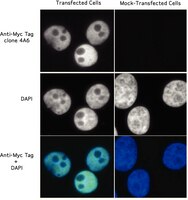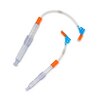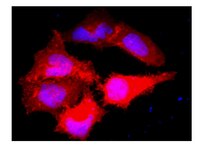Ubiquitously expressed transcript is a novel interacting protein of protein inhibitor of activated signal transducer and activator of transcription 2.
Kong, X; Ma, S; Guo, J; Ma, Y; Hu, Y; Wang, J; Zheng, Y
Molecular medicine reports
11
2443-8
2015
Show Abstract
Protein inhibitor of activated signal transducer and activator of transcription 2 (PIAS2) is a member of the PIAS protein family. This protein family modulates the activity of several transcription factors and acts as an E3 ubiquitin ligase in the sumoylation pathway. To improve understanding of the physiological roles of PIAS2, the current study used a yeast two‑hybrid system to screen mouse stem cell cDNA libraries for proteins that interact with PIAS2. The screening identified an interaction between PIAS2 and ubiquitously expressed transcript (UXT). UXT, also termed androgen receptor trapped clone‑27, is an α‑class prefoldin‑type chaperone that acts as a coregulator for various transcription factors, including nuclear factor‑κB and androgen receptor (AR). A direct interaction between PIAS2 and UXT was confirmed by direct yeast two‑hybrid analysis. In vitro evidence of the association of UXT with PIAS2 was obtained by co‑immunoprecipitation. Colocalization between PIAS2 and UXT was identified in the nucleus and cytoplasm of HEK 293T and human cervical carcinoma HeLa cells. The results of the current study suggested that UXT is a binding protein of PIAS2, and interaction between PIAS2 and UXT may be important for the transcriptional activation of AR. | | | 25434787
 |
Dopaminergic and glutamatergic microdomains in a subset of rodent mesoaccumbens axons.
Zhang, S; Qi, J; Li, X; Wang, HL; Britt, JP; Hoffman, AF; Bonci, A; Lupica, CR; Morales, M
Nature neuroscience
18
386-92
2015
Show Abstract
Mesoaccumbens fibers are thought to co-release dopamine and glutamate. However, the mechanism is unclear, and co-release by mesoaccumbens fibers has not been documented. Using electron microcopy, we found that some mesoaccumbens fibers have vesicular transporters for dopamine (VMAT2) in axon segments that are continuous with axon terminals that lack VMAT2, but contain vesicular glutamate transporters type 2 (VGluT2). In vivo overexpression of VMAT2 did not change the segregation of the two vesicular types, suggesting the existence of highly regulated mechanisms for maintaining this segregation. The mesoaccumbens axon terminals containing VGluT2 vesicles make asymmetric synapses, commonly associated with excitatory signaling. Using optogenetics, we found that dopamine and glutamate were released from the same mesoaccumbens fibers. These findings reveal a complex type of signaling by mesoaccumbens fibers in which dopamine and glutamate can be released from the same axons, but are not normally released at the same site or from the same synaptic vesicles. | | | 25664911
 |
CHK1-driven histone H3.3 serine 31 phosphorylation is important for chromatin maintenance and cell survival in human ALT cancer cells.
Chang, FT; Chan, FL; R McGhie, JD; Udugama, M; Mayne, L; Collas, P; Mann, JR; Wong, LH
Nucleic acids research
43
2603-14
2015
Show Abstract
Human ALT cancers show high mutation rates in ATRX and DAXX. Although it is well known that the absence of ATRX/DAXX disrupts H3.3 deposition at heterochromatin, its impact on H3.3 deposition and post-translational modification in the global genome remains unclear. Here, we explore the dynamics of phosphorylated H3.3 serine 31 (H3.3S31ph) in human ALT cancer cells. While H3.3S31ph is found only at pericentric satellite DNA repeats during mitosis in most somatic human cells, a high level of H3.3S31ph is detected on the entire chromosome in ALT cells, attributable to an elevated CHK1 activity in these cells. Drug inhibition of CHK1 activity during mitosis and expression of mutant H3.3S31A in these ALT cells result in a decrease in H3.3S31ph levels accompanied with increased levels of phosphorylated H2AX serine 139 on chromosome arms and at the telomeres. Furthermore, the inhibition of CHK1 activity in these cells also reduces cell viability. Our findings suggest a novel role of CHK1 as an H3.3S31 kinase, and that CHK1-mediated H3.3S31ph plays an important role in the maintenance of chromatin integrity and cell survival in ALT cancer cells. | | | 25690891
 |
Increased classical endoplasmic reticulum stress is sufficient to reduce chondrocyte proliferation rate in the growth plate and decrease bone growth.
Kung, LH; Rajpar, MH; Preziosi, R; Briggs, MD; Boot-Handford, RP
PloS one
10
e0117016
2015
Show Abstract
Mutations in genes encoding cartilage oligomeric matrix protein and matrilin-3 cause a spectrum of chondrodysplasias called multiple epiphyseal dysplasia (MED) and pseudoachondroplasia (PSACH). The majority of these diseases feature classical endoplasmic reticulum (ER) stress and activation of the unfolded protein response (UPR) as a result of misfolding of the mutant protein. However, the importance and the pathological contribution of ER stress in the disease pathogenesis are unknown. The aim of this study was to investigate the generic role of ER stress and the UPR in the pathogenesis of these diseases. A transgenic mouse line (ColIITgcog) was generated using the collagen II promoter to drive expression of an ER stress-inducing protein (Tgcog) in chondrocytes. The skeletal and histological phenotypes of these ColIITgcog mice were characterised. The expression and intracellular retention of Tgcog induced ER stress and activated the UPR as characterised by increased BiP expression, phosphorylation of eIF2α and spliced Xbp1. ColIITgcog mice exhibited decreased long bone growth and decreased chondrocyte proliferation rate. However, there was no disruption of chondrocyte morphology or growth plate architecture and perturbations in apoptosis were not apparent. Our data demonstrate that the targeted induction of ER stress in chondrocytes was sufficient to reduce the rate of bone growth, a key clinical feature associated with MED and PSACH, in the absence of any growth plate dysplasia. This study establishes that classical ER stress is a pathogenic factor that contributes to the disease mechanism of MED and PSACH. However, not all the pathological features of MED and PSACH were recapitulated, suggesting that a combination of intra- and extra-cellular factors are likely to be responsible for the disease pathology as a whole. | | | 25693198
 |
Evidence for ubiquitin-regulated nuclear and subnuclear trafficking among Paramyxovirinae matrix proteins.
Pentecost, M; Vashisht, AA; Lester, T; Voros, T; Beaty, SM; Park, A; Wang, YE; Yun, TE; Freiberg, AN; Wohlschlegel, JA; Lee, B
PLoS pathogens
11
e1004739
2015
Show Abstract
The paramyxovirus matrix (M) protein is a molecular scaffold required for viral morphogenesis and budding at the plasma membrane. Transient nuclear residence of some M proteins hints at non-structural roles. However, little is known regarding the mechanisms that regulate the nuclear sojourn. Previously, we found that the nuclear-cytoplasmic trafficking of Nipah virus M (NiV-M) is a prerequisite for budding, and is regulated by a bipartite nuclear localization signal (NLSbp), a leucine-rich nuclear export signal (NES), and monoubiquitination of the K258 residue within the NLSbp itself (NLSbp-lysine). To define whether the sequence determinants of nuclear trafficking identified in NiV-M are common among other Paramyxovirinae M proteins, we generated the homologous NES and NLSbp-lysine mutations in M proteins from the five major Paramyxovirinae genera. Using quantitative 3D confocal microscopy, we determined that the NES and NLSbp-lysine are required for the efficient nuclear export of the M proteins of Nipah virus, Hendra virus, Sendai virus, and Mumps virus. Pharmacological depletion of free ubiquitin or mutation of the conserved NLSbp-lysine to an arginine, which inhibits M ubiquitination, also results in nuclear and nucleolar retention of these M proteins. Recombinant Sendai virus (rSeV-eGFP) bearing the NES or NLSbp-lysine M mutants rescued at similar efficiencies to wild type. However, foci of cells expressing the M mutants displayed marked fusogenicity in contrast to wild type, and infection did not spread. Recombinant Mumps virus (rMuV-eGFP) bearing the homologous mutations showed similar defects in viral morphogenesis. Finally, shotgun proteomics experiments indicated that the interactomes of Paramyxovirinae M proteins are significantly enriched for components of the nuclear pore complex, nuclear transport receptors, and nucleolar proteins. We then synthesize our functional and proteomics data to propose a working model for the ubiquitin-regulated nuclear-cytoplasmic trafficking of cognate paramyxovirus M proteins that show a consistent nuclear trafficking phenotype. | | | 25782006
 |
DRAM-3 modulates autophagy and promotes cell survival in the absence of glucose.
Mrschtik, M; O'Prey, J; Lao, LY; Long, JS; Beaumatin, F; Strachan, D; O'Prey, M; Skommer, J; Ryan, KM
Cell death and differentiation
22
1714-26
2015
Show Abstract
Macroautophagy is a membrane-trafficking process that delivers cytoplasmic constituents to lysosomes for degradation. The process operates under basal conditions as a mechanism to turnover damaged or misfolded proteins and organelles. As a result, it has a major role in preserving cellular integrity and viability. In addition to this basal function, macroautophagy can also be modulated in response to various forms of cellular stress, and the rate and cargoes of macroautophagy can be tailored to facilitate appropriate cellular responses in particular situations. The macroautophagy machinery is regulated by a group of evolutionarily conserved autophagy-related (ATG) proteins and by several other autophagy regulators, which either have tissue-restricted expression or operate in specific contexts. We report here the characterization of a novel autophagy regulator that we have termed DRAM-3 due to its significant homology to damage-regulated autophagy modulator (DRAM-1). DRAM-3 is expressed in a broad spectrum of normal tissues and tumor cells, but different from DRAM-1, DRAM-3 is not induced by p53 or DNA-damaging agents. Immunofluorescence studies revealed that DRAM-3 localizes to lysosomes/autolysosomes, endosomes and the plasma membrane, but not the endoplasmic reticulum, phagophores, autophagosomes or Golgi, indicating significant overlap with DRAM-1 localization and with organelles associated with macroautophagy. In this regard, we further proceed to show that DRAM-3 expression causes accumulation of autophagosomes under basal conditions and enhances autophagic flux. Reciprocally, CRISPR/Cas9-mediated disruption of DRAM-3 impairs autophagic flux confirming that DRAM-3 is a modulator of macroautophagy. As macroautophagy can be cytoprotective under starvation conditions, we also tested whether DRAM-3 could promote survival on nutrient deprivation. This revealed that DRAM-3 can repress cell death and promote long-term clonogenic survival of cells grown in the absence of glucose. Interestingly, however, this effect is macroautophagy-independent. In summary, these findings constitute the primary characterization of DRAM-3 as a modulator of both macroautophagy and cell survival under starvation conditions. | | | 25929859
 |
Human rhinovirus 16 causes Golgi apparatus fragmentation without blocking protein secretion.
Mousnier, A; Swieboda, D; Pinto, A; Guedán, A; Rogers, AV; Walton, R; Johnston, SL; Solari, R
Journal of virology
88
11671-85
2014
Show Abstract
The replication of picornaviruses has been described to cause fragmentation of the Golgi apparatus that blocks the secretory pathway. The inhibition of major histocompatibility complex class I upregulation and cytokine, chemokine and interferon secretion may have important implications for host defense. Previous studies have shown that disruption of the secretory pathway can be replicated by expression of individual nonstructural proteins; however the situation with different serotypes of human rhinovirus (HRV) is unclear. The expression of 3A protein from HRV14 or HRV2 did not cause Golgi apparatus disruption or a block in secretion, whereas other studies showed that infection of cells with HRV1A did cause Golgi apparatus disruption which was replicated by the expression of 3A. HRV16 is the serotype most widely used in clinical HRV challenge studies; consequently, to address the issue of Golgi apparatus disruption for HRV16, we have systematically and quantitatively examined the effect of HRV16 on both Golgi apparatus fragmentation and protein secretion in HeLa cells. First, we expressed each individual nonstructural protein and examined their cellular localization and their disruption of endoplasmic reticulum and Golgi apparatus architecture. We quantified their effects on the secretory pathway by measuring secretion of the reporter protein Gaussia luciferase. Finally, we examined the same outcomes following infection of cells with live virus. We demonstrate that expression of HRV16 3A and 3AB and, to a lesser extent, 2B caused dispersal of the Golgi structure, and these three nonstructural proteins also inhibited protein secretion. The infection of cells with HRV16 also caused significant Golgi apparatus dispersal; however, this did not result in the inhibition of protein secretion. Importance: The ability of replicating picornaviruses to influence the function of the secretory pathway has important implications for host defense. However, there appear to be differences between different members of the family and inconsistent results when comparing infection with live virus to expression of individual nonstructural proteins. We demonstrate that individual nonstructural HRV16 proteins, when expressed in HeLa cells, can both fragment the Golgi apparatus and block secretion, whereas viral infection fragments the Golgi apparatus without blocking secretion. This has major implications for how we interpret mechanistic evidence derived from the expression of single viral proteins. | | | 25100828
 |
The yeast Cyc8-Tup1 complex cooperates with Hda1p and Rpd3p histone deacetylases to robustly repress transcription of the subtelomeric FLO1 gene.
Fleming, AB; Beggs, S; Church, M; Tsukihashi, Y; Pennings, S
Biochimica et biophysica acta
1839
1242-55
2014
Show Abstract
We demonstrate that the yeast flocculation gene, FLO1, is representative of a distinct subset of subtelomeric genes that are robustly repressed by the Cyc8-Tup1 complex. We have examined Cyc8-Tup1 localisation, histone acetylation and long-range chromatin remodelling within the extensive FLO1 upstream region. We show that Cyc8-Tup1 is localised in a DNase I hypersensitive site within an ordered array of strongly positioned nucleosomes around -700 base pairs upstream of the transcription start site. In cyc8 deletion mutant strains, Tup1p localisation is absent, with concomitant histone hyperacetylation of adjacent regions at the FLO1 promoter. This is accompanied by extensive histone depletion across the upstream region and gene activation. The yeast histone deacetylases, Hda1p and Rpd3p, occupy the repressed FLO1 promoter region in a Cyc8-Tup1 dependent manner and coordinate histone deacetylation, nucleosome stabilisation and gene repression. Moreover, we show that the ATP-dependent chromatin remodelling complex Swi-Snf occupies the site vacated by Cyc8-Tup1 in a cyc8 mutant. These data suggest that distinctly bound Cyc8-Tup1 cooperates with Hda1p and Rpd3p to establish or maintain an extensive array of strongly positioned, deacetylated nucleosomes over the FLO1 promoter and upstream region which inhibit histone acetylation, block Swi-Snf binding and prevent transcription. | | | 25106892
 |
The type III secretion effector NleF of enteropathogenic Escherichia coli activates NF-κB early during infection.
Pallett, MA; Berger, CN; Pearson, JS; Hartland, EL; Frankel, G
Infect Immun
82
4878-88
2014
Show Abstract
The enteric pathogens enteropathogenic Escherichia coli (EPEC) and enterohemorrhagic E. coli employ a type 3 secretion system (T3SS) to manipulate the host inflammatory response during infection. Previously, it has been reported that EPEC, in a T3SS-dependent manner, induces an early proinflammatory response through activation of NF-κB via extracellular signal-regulated kinases 1 and 2 (ERK1/2) and protein kinase Cζ (PKCζ). However, the activation of NF-κB during infection has not yet been attributed to an effector. At later time points postinfection, NF-κB signaling is inhibited through the translocation of multiple effectors, including NleE and NleC. Here we report that the highly conserved non-LEE (locus of enterocyte effacement)-encoded effector F (NleF) shows both diffuse and mitochondrial localization during ectopic expression. Moreover, NleF induces the nuclear translocation of NF-κB p65 and the expression of interleukin 8 (IL-8) following ectopic expression and during EPEC infection. Furthermore, the proinflammatory activity and localization of NleF were dependent on the C-terminal amino acids LQCG. While the C-terminal domain of NleF has previously been shown to be essential for interaction with caspase-4, caspase-8, and caspase-9, the proinflammatory activity of NleF was independent of interaction with caspase-4, -8, or -9. In conclusion, EPEC, through the T3SS-dependent translocation of NleF, induces a proinflammatory response in an NF-κB-dependent manner in the early stages of infection. | | | 25183730
 |
Dispersed and conserved hydrophobic residues of HIV-1 Vif are essential for CBFβ recruitment and A3G suppression.
Zhou, X; Han, X; Zhao, K; Du, J; Evans, SL; Wang, H; Li, P; Zheng, W; Rui, Y; Kang, J; Yu, XF
Journal of virology
88
2555-63
2014
Show Abstract
CBFβ was recently found to be a key regulator of the ability of human immunodeficiency virus type 1 (HIV-1) Vif to overcome host antiviral APOBEC3 proteins. However, the detailed molecular requirements for the Vif-CBFβ interaction are still not clear. Here, we mapped the minimum Vif domain required for CBFβ binding. In terms of CBFβ binding, the Vif N terminus was very sensitive to deletions. We determined that the Vif fragment from residues 5 to 126 was sufficient to form a stable complex with CBFβ in vitro. We also observed that ionic interactions were not the main contributor to the interaction between Vif and CBFβ. Instead, hydrophobic interactions were important for maintaining the Vif-CBFβ complex, since it could be disrupted by nonionic detergent. Site-directed mutagenesis of conserved hydrophobic amino acids revealed novel residues in Vif that were important for CBFβ binding and APOBEC3 inactivation. At least part of the well-characterized HCCH domain (residues 108 to 139) was required to form a stable Vif-CBFβ complex. Thus, the HCCH motif may have a dual role in binding both Cul5 and CBFβ. Considering the importance of Vif in HIV-1 infection, this unique Vif-CBFβ interaction represents an attractive pharmacological intervention target against HIV-1.Vif-induced APOBEC3 protein degradation was the first host antiviral mechanism against HIV-1/simian immunodeficiency virus to be revealed, yet details regarding which proteins are degraded are not fully demonstrated. Recently, host cellular factor CBFβ was found to be essential for Vif to function and promote viral infectivity. In this study, we present more critical information on the Vif-CBFβ interaction by revealing that hydrophobicity contributes the most to the Vif-CBFβ interaction and locating several novel hydrophobic sites (tryptophans and phenylalanines) that are conserved among Vif proteins from different lentiviruses and essential for Vif binding to CBFβ. Mutations on these sites result in a reduced/abolished Vif-CBFβ interaction, leading to the attenuated potency of Vif on both inducing the degradation of antiviral factors like APOBEC3G and promoting HIV-1 infectivity. Therefore, information from this study will help people to further understand how Vif acts against host antiviral mechanism, which is important for novel anti-HIV-1 drug development. | | | 24352440
 |
























